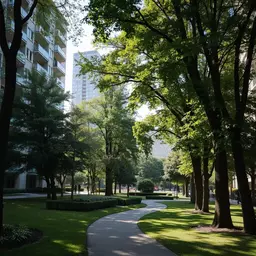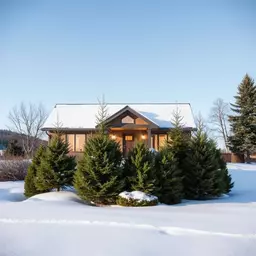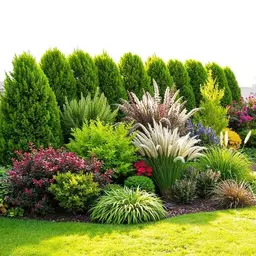Trees for Privacy and Care
Ever thought about how a well-placed tree can not only enhance privacy but also beautify your surroundings? As the world becomes more urbanized, the need for personal space in our outdoor environments grows. This article dives into the essential role of trees in landscape design, particularly in creating effective privacy borders.
What You Will Learn
- The importance of privacy borders in outdoor spaces for enhanced comfort and enjoyment.
- Key benefits of using trees for privacy, including year-round coverage and noise reduction.
- Effective landscaping techniques, such as layering plants, to create visually appealing privacy barriers.
- Criteria for selecting the right trees, including evergreens for consistent privacy and native species for ecological benefits.
- The pivotal role of certified arborists in maintaining tree health and ensuring the longevity of privacy borders.
- Steps to take action toward enhancing privacy in your landscape, including consulting with an arborist.
Key Benefits of Using Trees for Privacy
Here are some key advantages of incorporating trees into your privacy borders:
Year-Round Privacy
Evergreens provide consistent coverage, even in winter.
Environmental Benefits
Trees improve air quality and support local wildlife.
Noise Reduction
Dense foliage can help muffle unwanted sounds from nearby roads or neighbors.
Natural Beauty
Trees provide seasonal interest, from colorful blossoms in spring to vibrant foliage in fall.
Understanding Privacy Borders: The Role of Trees in Landscape Design
Creating a truly peaceful outdoor space is all about crafting effective privacy borders. These borders act as natural shields, allowing you to enjoy your yard without the intrusion of prying eyes. At Branch & Border, I believe that trees and shrubs not only enhance the beauty of your landscape but also serve practical purposes, particularly in providing privacy.
Privacy borders can be defined as the natural or artificial boundaries that shield personal spaces from external views. They can take various forms, including fences, walls, and, of course, living borders made of trees and shrubs. The beauty of using trees lies in their ability to grow and adapt, creating a dynamic living barrier that can transform your outdoor experience. For more information on the various benefits of trees in urban environments, consider exploring resources from the U.S. Forest Service on Urban Forestry.
Defining Privacy Borders: What They Are and Why They Matter
Privacy borders are essential for a variety of reasons. They offer a sense of shelter and seclusion, allowing you to fully enjoy your outdoor space. Without adequate privacy, outdoor activities can feel exposed and uncomfortable, dampening your enjoyment of nature.
Moreover, privacy borders can enhance the overall aesthetic of your property. They frame your space beautifully while also providing practical benefits like noise reduction and wind protection. This combination of functionality and beauty makes them a vital component of landscape design.
Key Benefits of Using Trees for Privacy: Beyond Aesthetic Appeal
When considering trees for your privacy borders, the benefits extend far beyond mere looks. Here are some key advantages:
- Year-Round Privacy: Evergreens provide consistent coverage, even in winter.
- Environmental Benefits: Trees improve air quality and support local wildlife.
- Noise Reduction: Dense foliage can help muffle unwanted sounds from nearby roads or neighbors.
- Natural Beauty: Trees provide seasonal interest, from colorful blossoms in spring to vibrant foliage in fall.
At Branch & Border, I value these benefits and strive to incorporate them into every landscape design. It's not just about planting trees; it's about creating a harmonious environment that enhances your quality of life.
The Contribution of Landscaping to Privacy Solutions
Landscaping plays a crucial role in establishing effective privacy borders. Thoughtful design includes the strategic placement of trees, shrubs, and other plants, creating a layered effect that offers both visual appeal and protection. By varying heights and types of plants, you can create a lush and inviting atmosphere.
Additionally, landscaping can guide how spaces are utilized. For instance, incorporating pathways or seating areas surrounded by greenery can encourage outdoor gatherings while maintaining a sense of seclusion. This kind of design not only enhances privacy but also maximizes the use of your outdoor areas.
- Layering Plants: Use taller trees at the back, medium shrubs in the middle, and low plants in front for depth.
- Mixing Species: Incorporate a variety of plants to enhance biodiversity and visual interest.
- Seasonal Changes: Choose a mix of evergreens and deciduous plants to provide year-round privacy, while also enjoying seasonal beauty.
By investing time and thought into your landscaping, you can create a private oasis in your own backyard, one that invites comfort and peace. I love helping my clients at Branch & Border discover how to define their spaces in a way that feels personal and inviting!
FAQs About Privacy Borders and Tree Care
- Q: What are privacy borders?
- A: Privacy borders are natural or artificial boundaries, such as trees, shrubs, fences, or walls, designed to shield personal outdoor spaces from external views, enhancing seclusion and comfort.
- Q: What are the key benefits of using trees for privacy?
- A: Trees offer numerous benefits, including year-round privacy (especially evergreens), environmental improvements (air quality, wildlife support), noise reduction from dense foliage, and natural beauty through seasonal changes.
- Q: How can landscaping contribute to effective privacy solutions?
- A: Landscaping creates privacy through strategic placement and layering of plants, mixing species for biodiversity, and choosing a combination of evergreens and deciduous plants for year-round coverage and seasonal beauty.
- Q: What factors should I consider when choosing trees for optimal privacy?
- A: Key factors include climate compatibility, soil conditions, local regulations, the desired level of privacy (year-round vs. seasonal), and whether to prioritize native species for ecological benefits.
- Q: Why is hiring a certified arborist important for maintaining privacy borders?
- A: Certified arborists provide expert knowledge for tree health management, including proper pruning, disease diagnosis, and pest management. Their expertise ensures the longevity and vitality of your privacy trees, reducing long-term costs and preventing potential issues.
Choosing the Right Trees for Optimal Privacy: Factors to Consider
In the next section, we’ll explore how to choose the right trees for your privacy needs, considering various factors such as climate, soil, and local regulations. Selecting the appropriate species is vital for ensuring that your privacy borders thrive over time.
Pro Tip
When planning your privacy borders, consider incorporating a mix of tree species that bloom at different times of the year. This strategy not only enhances the visual appeal of your landscape but also ensures that your outdoor space offers privacy and beauty throughout the seasons. For example, pairing evergreens with flowering deciduous trees can provide year-round coverage while also showcasing vibrant colors in spring and summer.
Trees, Privacy, and Professional Care
As we reflect on the importance of incorporating trees into landscape design for privacy, it's clear that the right choices can transform your outdoor space. At Branch & Border, I emphasize the significance of selecting suitable tree species for your privacy borders. Understanding how different trees serve specific purposes can make a world of difference!
Here are some key takeaways regarding tree selection for privacy:
- Evergreen Trees: These provide year-round coverage, ensuring that your space feels secluded in all seasons.
- Deciduous Trees: Ideal for seasonal privacy, they offer lush foliage during warmer months while allowing sunlight in during winter.
- Native Trees: Choosing trees that flourish in your local ecosystem supports wildlife and enhances the natural beauty of your landscape.
In summary, understanding the role of trees not only enhances aesthetics but also creates a protective barrier that increases the enjoyment of your outdoor space.
Importance of Arborist Expertise in Tree Health Management
Hiring a certified arborist ensures that your chosen trees thrive in their environment. Arborists offer specialized knowledge that guides you in maintaining tree health, ensuring that your privacy borders remain lush and vibrant. At Branch & Border, I often find that investing in professional care reduces long-term costs and prevents potential issues.
Some benefits of working with a certified arborist include:
- Expert Pruning and Trimming: A well-maintained tree can offer better coverage and longevity.
- Diagnosis of Diseases: Arborists are trained to identify symptoms early, preventing the spread of diseases.
- Pest Management: They can recommend targeted treatments to keep your trees healthy and thriving.
Ultimately, the professional care of your trees is crucial to achieving the privacy and aesthetic beauty that enhances your property. For further insights into tree care and selection, the University of Florida IFAS Extension offers valuable resources on selecting trees for Florida landscapes, which can be broadly applied to understanding tree characteristics relevant for privacy borders.
Your Next Steps to Enhance Privacy with Trees
Now that you understand the importance of trees for privacy and the role of arborists, it's time to take action! A simple first step is to consult with a certified arborist to assess your specific needs and develop a personalized plan. At Branch & Border, I love helping clients find the right solutions tailored to their individual landscapes.
Consulting with a Certified Arborist: Getting Started
To begin your journey toward enhanced privacy, consider the following steps:
- Research Local Arborists: Look for certified professionals with solid reviews and experience.
- Schedule an Initial Consultation: Discuss your goals and preferences regarding privacy borders.
- Ask Questions: Don’t hesitate to inquire about their methods and tree care plans.
Taking these steps can help you create a plan that aligns with your vision and ensures the health of your trees.
Testimonials and Case Studies of Successful Privacy Borders
Your experiences are valuable! Sharing testimonials or case studies about your journey with privacy borders can inspire others. At Branch & Border, I encourage clients to document their transformations. This not only highlights the beauty of their new landscapes but also fosters a community where we can all learn from each other.
Exploring Urban Forestry
Finally, don’t forget the broader impact trees can have in urban areas. Participating in local urban forestry initiatives can help improve community privacy and foster collaboration. Initiatives often focus on planting trees in public spaces, enhancing the green cover while providing benefits like improved air quality and habitat for wildlife.
Let’s work together to create our own green spaces that not only serve our individual needs but enrich our communities as well!
Recap of Key Points
Here is a quick recap of the important points discussed in the article:
- Privacy Borders: Essential for creating shelter and seclusion in outdoor spaces, enhancing both comfort and enjoyment.
- Benefits of Trees: Trees provide year-round privacy, environmental benefits, noise reduction, and seasonal beauty.
- Landscaping Techniques: Layering plants and mixing species can enhance privacy while adding visual interest to your landscape.
- Tree Selection: Choose evergreens for consistent coverage, deciduous trees for seasonal beauty, and native species for ecological support.
- Arborist Expertise: Hiring certified arborists ensures proper tree care, which is critical for maintaining healthy privacy borders.
- Action Steps: Consult with an arborist to assess your landscape needs and develop a tailored plan for enhancing privacy.






